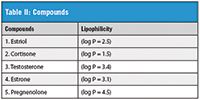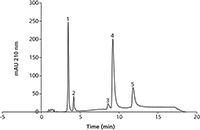Separation of Five Steroids on a C18-Functionalized Polymeric Reversed-Phase HPLC Column (PRP-C18)
Steroids represent a chemically distinct class of hormones with wide-ranging biological functions. Synthetic derivatives of endogenous steroid prototypes are used medically in birth control and in the treatment of asthma, arthritis, inflammation, and osteoporosis.
Steroids represent a chemically distinct class of hormones with wide-ranging biological functions. Synthetic derivatives of endogenous steroid prototypes are used medically in birth control and in the treatment of asthma, arthritis, inflammation, and osteoporosis.

Table I: Experimental conditions
Steroids share a characteristic, polycyclic structure and have varying degrees of lipophilicity (log P). In this study, a reversed-phase HPLC method was developed for separation of five steroid hormones with partition coefficients ranging from 1.47 (cortisone) to 4.5 (pregnenolone) on a Hamilton PRP-C18 HPLC column.

Table II: Compounds

Figure 1: Separation of five steroids on a 4.6 Ã 150 mm PRP-C18.
© 2014 Hamilton Company. All rights reserved. All trademarks are owned and/or registered by Hamilton Company in the U.S. and/or other countries. 04/2014 Lit. No. L80086 Rev. B

Hamilton Company
4970 Energy Way, Reno, NV 89502
tel. (775) 858-3000, (800) 648-5950
Website: www.hamiltoncompany.com

SEC-MALS of Antibody Therapeutics—A Robust Method for In-Depth Sample Characterization
June 1st 2022Monoclonal antibodies (mAbs) are effective therapeutics for cancers, auto-immune diseases, viral infections, and other diseases. Recent developments in antibody therapeutics aim to add more specific binding regions (bi- and multi-specificity) to increase their effectiveness and/or to downsize the molecule to the specific binding regions (for example, scFv or Fab fragment) to achieve better penetration of the tissue. As the molecule gets more complex, the possible high and low molecular weight (H/LMW) impurities become more complex, too. In order to accurately analyze the various species, more advanced detection than ultraviolet (UV) is required to characterize a mAb sample.















